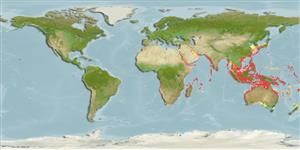A pelagic fish, inhabiting near edge of continental shelf to shallow coastal waters, often of low salinity and high turbidity (Ref. 30199, 48637); also found in drop-offs, and shallow or gently sloping reef and lagoon waters (Ref. 1602, 48637). Feed primarily on small fishes like anchovies, clupeids, carangids, also squids and penaeoid shrimps. Usually hunts solitary and often swim in shallow water along coastal slopes (Ref. 48637). Eggs and larvae are pelagic (Ref. 6769). Caught mainly with drift gill nets, bamboo stake traps, midwater trawls, and by trolling. Marketed mainly fresh; also dried-salted; commonly made into fish balls (Ref. 9684), frozen, smoked, and canned (Ref. 9987). A lipid-soluble toxin, similar to ciguatoxin has been found in the flesh of specimens caught on the east coast of Queensland, Australia. Known to undertake lengthy long-shore migrations, but permanent resident populations also seem to exist.
从大陆棚的近边缘到沿岸浅水区分布了, 时常低盐度与高混浊度.(参考文献 30199,48637) 也发现于海峭壁 , 与水浅或缓斜坡的礁与舄湖水域。 (参考文献 1602,48637) 通常沿着海岸的斜坡狩猎独居性而且时常在浅水区中游泳。 (参考文献 48637) 已知进行长途的沿岸回游, 但是永久的定居族群也似乎存在。 发现于小群鱼群了。 (参考文献 9684) 主要捕食像鳀鱼,鲱鱼,鲹,也捕食乌贼与对虾的小鱼。 一个脂质-溶解的毒素, 类似 ciguatoxin 已经被发现于在澳洲的昆士兰省的東海岸上面捕獲的標本的肉。 在市場上銷售生鮮地了, 被凍結,煙燻, 與罐裝的乾燥鹽醃 (參考文獻 9684);(參考文獻 9987) 通常製成了魚丸。
Preferred temperature (Ref.
115969): 22.8 - 29, mean 28 (based on 1324 cells).
Phylogenetic diversity index (Ref.
82804): PD
50 = 0.5000 [Uniqueness, from 0.5 = low to 2.0 = high].
Bayesian length-weight: a=0.00661 (0.00584 - 0.00747), b=3.00 (2.97 - 3.03), in cm Total Length, based on LWR estimates for this species (Ref.
93245).
营养阶层 (Ref.
69278): 4.5 ±0.4 se; based on diet studies.
回复力 (Ref.
120179): 中等的, 族群倍增时间最少 1.4 - 4.4年 (K=0.12-0.21; tm=2-3; tmax=14; Fec=590,000).
Prior r = 0.77, 95% CL = 0.51 - 1.15, Based on 5 stock assessments.
Fishing Vulnerability (Ref.
59153): Moderate to high vulnerability (52 of 100).
Climate Vulnerability (Ref.
125649): High to very high vulnerability (75 of 100).
